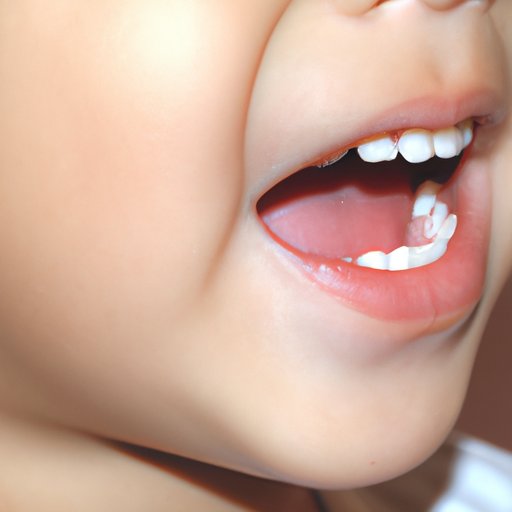Introduction
As parents, we all know the excitement that comes with watching your child’s baby teeth grow in and fall out. But with so many factors that can impact the order in which baby teeth fall out, it’s easy to feel overwhelmed. In this article, we will provide a comprehensive guide to primary teeth eruption and tooth loss. We’ll discuss the timeline of primary teeth eruption, the importance of baby teeth, and explore factors that can impact when and why baby teeth fall out. We’ll also provide tips for parents on how to care for their child’s teeth during this process, as well as coping mechanisms for both parents and children.
Timeline of Primary Teeth Eruption
The timeline for primary teeth eruption typically begins around six months of age. By age three, most children will have 20 baby teeth, which will eventually fall out to make way for permanent teeth. The general order of primary teeth eruption includes the bottom two front teeth, followed by the top two front teeth. From there, the teeth on each side of the front teeth will begin to grow in.
However, it’s important to keep in mind that the order in which baby teeth fall out can vary greatly from child to child. Genetics, nutrition, and oral hygiene habits can all impact when and why baby teeth fall out. To encourage healthy dental development in your child, make sure they brush their teeth twice daily, floss daily, and see a dentist every six months.
The Importance of Baby Teeth and When They Fall Out
Baby teeth may be temporary, but they play a crucial role in our child’s oral health and development. They help children develop the ability to speak and chew properly, as well as set the stage for healthy permanent teeth. The order in which baby teeth fall out can also impact the alignment of permanent teeth as they grow in.
Generally, baby teeth will start to fall out around age six or seven, with the bottom front teeth typically being the first to go. As a parent, you can help your child take care of their teeth during this process by encouraging good oral hygiene habits. Make sure your child brushes their teeth twice daily, flosses once daily, and rinses with mouthwash. Additionally, try to limit sugary snacks and drinks, which can promote tooth decay.
The Connection Between Diet and Early Tooth Loss
What we eat can have a significant impact on our dental health, and this is especially true for children. A poor diet that’s high in sugar and lacking important nutrients can promote tooth decay and even lead to premature loss of baby teeth. Additionally, certain eating habits like chewing on hard objects or using teeth to open packages can also cause damage to baby teeth.
As a parent, you can help ensure your child gets the nutrients they need for healthy teeth and gums by providing a balanced diet that includes plenty of fruits, vegetables, and whole grains. Aim to limit sugary and processed foods, and encourage your child to drink water instead of juice or soda.
The Role of Genetics in Primary Teeth Loss
Genetics can play a significant role in the timing of primary teeth loss. Just like with the timing of primary teeth eruption, some children may naturally lose their baby teeth earlier or later than others. Additionally, siblings may experience different patterns of tooth replacement.
While we can’t change our genetics, as a parent, there are things you can do to support your child’s dental health. Encourage healthy dental hygiene habits, make sure your child eats a balanced diet, and take them to the dentist regularly.
Coping with Early Tooth Loss
Losing baby teeth can be an emotional experience for both children and parents, especially when it happens earlier than expected. As a parent, it’s essential to communicate with your child about the process and provide support as they navigate this change. To help your child cope with early tooth loss, offer plenty of reassurance and try to make the experience as positive as possible.
If your child is experiencing premature loss of baby teeth, rest assured that there are tooth replacement options available. These can include dental bridges, retainers, and even dental implants, depending on your child’s individual needs. Your child’s dentist can provide guidance on the best course of action.
Conclusion
In conclusion, understanding the timeline of primary teeth eruption and tooth loss can help parents better care for their child’s dental health. Encouraging healthy dental hygiene habits, promoting good nutrition, and communicating openly with your child about the process can make the experience positive and even exciting. Remember, if you have concerns about your child’s dental health or have questions about the tooth loss process, don’t hesitate to seek professional advice.
